Rubus
| Rubus | |
|---|---|
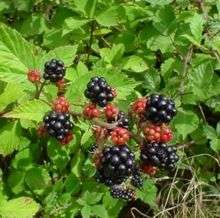 | |
| Rubus fruticosus | |
| Scientific classification | |
| Kingdom: | Plantae |
| (unranked): | Angiosperms |
| (unranked): | Eudicots |
| (unranked): | Rosids |
| Order: | Rosales |
| Family: | Rosaceae |
| Subfamily: | Rosoideae |
| Tribe: | Rubeae |
| Genus: | Rubus L.[1] |
| Type species | |
| Rubus fruticosus L.[2] | |
| Synonyms[1][3] | |
| Wikimedia Commons has media related to Rubus. |
| Wikispecies has information related to: Rubus |

Rubus is a large and diverse genus of flowering plants in the rose family, Rosaceae, subfamily Rosoideae, with 250–700 species.[4] Raspberries, blackberries, and dewberries are common, widely distributed members of the genus. Most of these plants have woody stems with prickles like roses; spines, bristles, and gland-tipped hairs are also common in the genus. The Rubus fruit, sometimes called a bramble fruit, is an aggregate of drupelets. The term "cane fruit" (or "cane-fruit") applies to any Rubus species or hybrid which is commonly grown with supports such as wires or canes, including raspberries, blackberries, and hybrids such as loganberry, boysenberry and tayberry.[5]
Overview
Most species are hermaphrodites, Rubus chamaemorus being an exception.
The blackberries, as well as various other Rubus species with mounding or rambling growth habits, are often called brambles. However, this name is not used for those like the raspberry that grow as upright canes, or for trailing or prostrate species, such as most dewberries, or various low-growing boreal, arctic, or alpine species.
The generic name means blackberry in Latin and was derived from the word ruber, meaning "red".[6]
The scientific study of brambles is known as "batology".
Examples of the hundreds of species of Rubus include:
- Rubus aboriginum
- Rubus abundus
- Rubus aculiferus
- Rubus adenocaulis
- Rubus adenotrichos
- Rubus adjacens
- Rubus alaskensis
- Rubus allegheniensis – Allegheny blackberry
- Rubus alnifolius
- Rubus alpinus
- Rubus alter
- Rubus alumnus
- Rubus amplior
- Rubus andrewsianus
- Rubus apogaeus
- Rubus aptatus
- Rubus arcticus – Arctic raspberry
- Rubus arcuans
- Rubus arenicola
- Rubus argutus
- Rubus arizonensis
- Rubus armeniacus – Himalayan blackberry
- Rubus arvensis
- Rubus audax
- Rubus baileyanus
- Rubus bartonianus
- Rubus bellobatus
- Rubus bicknellii
- Rubus biformispinus
- Rubus bifrons
- Rubus bigelovianus
- Rubus blanchardianus
- Rubus boyntonii
- Rubus burnhamii
- Rubus bushii
- Rubus caesius – European dewberry
- Rubus canadensis – Canadian blackberry
- Rubus centralis
- Rubus chamaemorus – Cloudberry
- Rubus clarus
- Rubus conanicutensis
- Rubus concameratus
- Rubus coriifolius
- Rubus coronarius
- Rubus coreanus - Bokbunja
- Rubus costaricanus
- Rubus cubitans
- Rubus cuneifolius – sand blackberry
- Rubus curtipes
- Rubus cymosus
- Rubus dalibarda
- Rubus deamii
- Rubus defectionis
- Rubus deliciosus
- Rubus densissimus
- Rubus depavitus
- Rubus discolor
- Rubus dissimilis
- Rubus domingensis
- Rubus durescens
- Rubus durus
- Rubus eggersii
- Rubus elegantulus
- Rubus ellipticus
- Rubus emeritus
- Rubus eriocarpus
- Rubus exeter
- Rubus exsularis
- Rubus fagifolius
- Rubus fecundus
- Rubus felix
- Rubus ferrugineus
- Rubus flagellaris
- Rubus flavinanus
- Rubus floricomus
- Rubus florulentus
- Rubus fraternalis
- Rubus frondisentis
- Rubus frondosus
- Rubus fruticosus agg. – blackberry
- Rubus fryei
- Rubus furtivus
- Rubus geniculatus
- Rubus geoides - Patagonian raspberry
- Rubus glandicaulis
- Rubus glaucifolius – San Diego raspberry
- Rubus glaucus
- Rubus gnarus
- Rubus grimesii
- Rubus griseus
- Rubus gulosus
- Rubus hancinianus
- Rubus hanesii
- Rubus harmonicus
- Rubus hawaiensis
- Rubus heterophyllus
- Rubus hispidoides
- Rubus hispidus
- Rubus hochstetterorum – Azorean blackberry
- Rubus humistratus
- Rubus huttonii
- Rubus hypolasius
- Rubus ictus
- Rubus idaeus – European red raspberry
- Rubus illecebrosus
- Rubus immanis
- Rubus impar
- Rubus inclinis
- Rubus inferior
- Rubus iniens
- Rubus insons
- Rubus insulanus
- Rubus invisus
- Rubus irasuensis
- Rubus ithacanus
- Rubus jacens
- Rubus jamaicensis
- Rubus junceus
- Rubus kelloggii
- Rubus kennedyanus
- Rubus laciniatus – cutleaf evergreen blackberry
- Rubus largus
- Rubus lasiococcus – roughfruit berry
- Rubus latens
- Rubus lawrencei
- Rubus leucodermis – whitebark raspberry or western raspberry
- Rubus leviculus
- Rubus liebmannii
- Rubus linkianus
- Rubus longii
- Rubus macraei
- Rubus macrogongylus
- Rubus macrophyllus
- Rubus macvaughii
- Rubus maniseesensis
- Rubus meracus
- Rubus michiganensis
- Rubus mirus
- Rubus miser
- Rubus missouricus
- Rubus mollior
- Rubus montensis
- Rubus multifer
- Rubus multiformis
- Rubus multispinus
- Rubus navus
- Rubus nefrens
- Rubus nelsonii
- Rubus neomexicanus
- Rubus nigerrimus
- Rubus nivalis
- Rubus niveus
- Rubus notatus
- Rubus novanglicus
- Rubus noveboracus
- Rubus novocaesarius
- Rubus obsessus
- Rubus obvius
- Rubus occidentalis – black raspberry
- Rubus odoratus – flowering raspberry
- Rubus oklahomus
- Rubus originalis
- Rubus ortivus
- Rubus ostryifolius
- Rubus paganus
- Rubus palmeri
- Rubus paludivagus
- Rubus parcifrondifer
- Rubus parlinii
- Rubus particeps
- Rubus particularis
- Rubus parviflorus – thimbleberry
- Rubus parvifolius – small-leaf bramble (Australia)
- Rubus pascuus
- Rubus pedatus
- Rubus pensilvanicus – Pennsylvania blackberry
- Rubus pergratus
- Rubus permixtus
- Rubus pernagaeus
- Rubus persistens
- Rubus perspicuus
- Rubus pervarius
- Rubus philadelphicus
- Rubus philyrophyllus
- Rubus phoenicolasius – wineberry
- Rubus pittieri
- Rubus plexus
- Rubus plicatifolius
- Rubus plus
- Rubus porteri
- Rubus positivus
- Rubus prestonensis
- Rubus pringlei
- Rubus probabilis
- Rubus probativus
- Rubus probus
- Rubus prosper
- Rubus provincialis
- Rubus pubescens – dwarf red blackberry
- Rubus pugnax
- Rubus pumilus
- Rubus quaesitus
- Rubus racemiger
- Rubus randolphiorum
- Rubus recurvans
- Rubus recurvicaulis
- Rubus reflexus – Rusty-hair Raspberry
- Rubus regionalis
- Rubus repens
- Rubus riograndis
- Rubus roribaccus
- Rubus rosa
- Rubus rosarius
- Rubus rosifolius
- Rubus rossbergianus
- Rubus russeus
- Rubus rydbergianus
- Rubus saltuensis
- Rubus sapidus
- Rubus saxatilis – stone bramble
- Rubus scambens
- Rubus scandens
- Rubus sceleratus
- Rubus schiedeanus
- Rubus schoolcraftianus
- Rubus segnis
- Rubus semisetosus
- Rubus setosus
- Rubus severus
- Rubus sewardianus
- Rubus sieboldii
- Rubus signatus
- Rubus sons
- Rubus spectabilis – salmonberry
- Rubus spectatus
- Rubus steelei
- Rubus stipulatus
- Rubus strigosus – American red raspberry
- Rubus superbus
- Rubus suppar
- Rubus suus
- Rubus tardatus
- Rubus tholiformis
- Rubus tomentosus
- Rubus trichomallus
- Rubus trifidus – Japanese blackberry
- Rubus trifrons
- Rubus trivialis
- Rubus tuerckheimii
- Rubus tygartensis
- Rubus ucetanus
- Rubus uhdeanus
- Rubus ulmifolius
- Rubus uniformis
- Rubus ursinus – trailing blackberry
- Rubus uvidus
- Rubus variispinus
- Rubus velox
- Rubus verae-crucis
- Rubus vermontanus
- Rubus vestitus
- Rubus vigilis
- Rubus vigoratus
- Rubus vulcanicola
- Rubus weatherbyi
- Rubus whartoniae
- Rubus wheeleri
- Rubus wisconsinensis
The British National Collection of Rubus is held by Barry Clark at Houghton, Hampshire. His collection stands at over 200 species and, although not within the scope of the National Collection, he also grows many cultivars.[7][8]
Hybrid berries
The term "hybrid berry" is often used collectively for those fruits in the genus Rubus which have been developed mainly in the USA and UK in the last 130 years. As Rubus species readily interbreed and are apomicts (able to set seed without fertilisation), the parentage of these plants is often highly complex, but is generally agreed to include cultivars of blackberries, (Rubus ursinus, R. fruticosus) and raspberries (R. idaeus).
The hybrid berries include:-[9]
- Loganberry (California, USA, 1883) R. × loganobaccus, a spontaneous cross between R. ursinus 'Aughinbaugh' and R. idaeus 'Red Antwerp'
- Boysenberry (USA, 1920s) a cross between R. idaeus and R. × loganobaccus
- Veitchberry (Europe, 1930s) a cross between R. fruticosus and R. idaeus
- Marionberry (1956) now thought to be a blackberry cultivar R. 'Marion'
- Silvanberry, R. 'Silvan', a cross between R. 'Marion' and boysenberry
- Tayberry (Dundee, Scotland, 1979), another blackberry/raspberry cross
- Tummelberry, R. 'Tummel', from the same Scottish breeding programme as tayberry
- Hildaberry (1980s), a tayberry/boysenberry cross discovered by an amateur grower
Scientific classification
The genus Rubus is a very complex one, particularly the blackberry/dewberry subgenus (Rubus), with polyploidy, hybridization, and facultative apomixis apparently all frequently occurring, making species classification of the great variation in the subgenus one of the grand challenges of systematic botany.
Rubus species have a basic chromosome number of seven. Polyploidy from the diploid (14 chromosomes) to the tetradecaploid (98 chromosomes) is exhibited.
Some treatments have recognized dozens of species each for what other, comparably qualified botanists have considered single, more variable species. On the other hand, species in the other Rubus subgenera (such as the raspberries) are generally distinct, or else involved in more routine one-or-a-few taxonomic debates, such as whether the European and American red raspberries are better treated as one species or two. (In this case, the two-species view is followed here, with Rubus idaeus and R. strigosus both recognized; if these species are combined, then the older name R. idaeus has priority for the broader species.)
Molecular data have backed up classifications based on geography and chromosome number, but following morphological data, such as the structure of the leaves and stems, do not appear to produce a phylogenetic classification.[10]
The classification presented below recognizes 13 subgenera within Rubus, with the largest subgenus (Rubus) in turn divided into 12 sections. Representative examples are presented, but many more species are not mentioned here.
|
|
See also
List of Lepidoptera that feed on Rubus
References
- 1 2 "Rubus L.". Germplasm Resources Information Network. United States Department of Agriculture. 2007-10-05. Retrieved 2010-06-27.
- ↑ "Rubus L.". TROPICOS. Missouri Botanical Garden. Retrieved 2010-06-27.
- ↑ Flora of North America, Rubus Linnaeus, 1753; Bramble
- ↑ Brouillet, L. (2015), "Rosaceae Jussieu (subfam. Rosoideae) tribe Rubeae Dumortier, Anal. Fam. Pl. 39. 1829", in L. Brouillet; K. Gandhi; C.L. Howard; H. Jeude; R.W. Kiger; J.B. Phipps; A.C. Pryor; H.H. Schmidt; J.L. Strother; J.L. Zarucchi, Flora of North America North of Mexico, Volume 9: Magnoliophyta: Picramniaceae to Rosaceae, New York, Oxford: Oxford University Press, pp. 27–28, ISBN 978-0-19-534029-7
- ↑ Klein, Carol (2009). Grow your own fruit. United Kingdom: Mitchell Beazley. p. 224. ISBN 9781845334345.
- ↑ Quattrocchi, Umberto (2000). CRC World Dictionary of Plant Names. IV R-Z. Taylor & Francis US. p. 2345. ISBN 978-0-8493-2678-3.
- ↑ National Collection of Rubus Species, Houghton, England, United Kingdom
- ↑ "Plant Heritage - National Collections Scheme, UK Garden Plants". nccpg.com. Retrieved 20 January 2015.
- ↑ Ardle, John (July 2013). "Hybris vigour". The Garden.
- ↑ Lawrence A. Alice & Christopher S. Campbell (1999). "Phylogeny of Rubus (rosaceae) based on nuclear ribosomal DNA internal transcribed spacer region sequences". American Journal of Botany. Botanical Society of America. 86 (1): 81–97. doi:10.2307/2656957. JSTOR 2656957. PMID 21680348.
External links
- Rubus at the Western Kentucky University
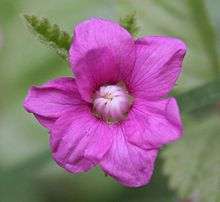

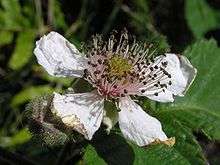
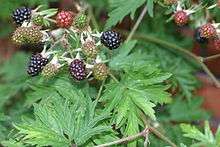
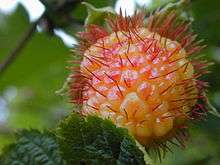

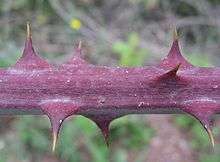
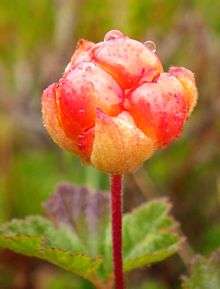
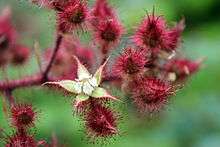

.jpg)